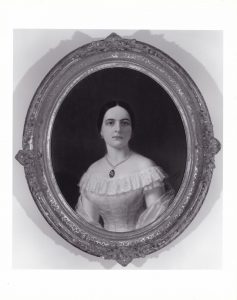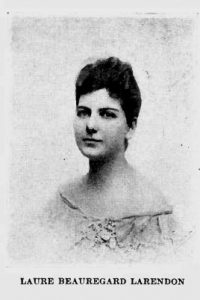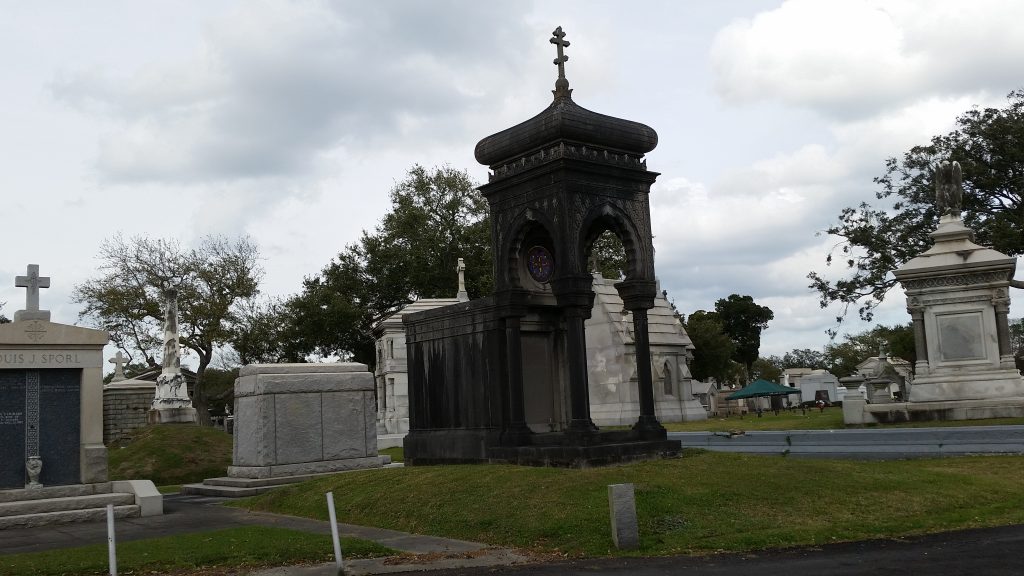Laure “Doucette” Larendon: Beauregard’s Daughter
 Among P.G.T. Beauregard his closest friends was Charles Villeré, son of Jules Villeré, a sugar cane planter in Plaquemines Parish and a member of one of the most prominent Creole families in south Louisiana. Beauregard became smitten with Marie Laure Villeré, Charles’ sister. The two married in September 1841 and had two sons, René and Henri.
Among P.G.T. Beauregard his closest friends was Charles Villeré, son of Jules Villeré, a sugar cane planter in Plaquemines Parish and a member of one of the most prominent Creole families in south Louisiana. Beauregard became smitten with Marie Laure Villeré, Charles’ sister. The two married in September 1841 and had two sons, René and Henri.
In March 1850, Laure, died in childbirth. Beauregard was shattered. He buried Laure in St. Bernard and hired Florville Foy, a free man of color and one of the city’s finest cemetery artists, to inscribe on the tomb in French, “Spirit from Heaven you have returned. Sleep in peace, daughter, wife and dear mother.”[1]

However, the infant survived, and Beauregard called her Laure, after her mother. As her father’s favorite, she mostly grew up at Magnolia Plantation with the Villeré family, but her father visited until he left for Montgomery, Alabama in 1861. From there, Beauregard traveled to Fort Sumter; he would not see Laure again until 1865.
By the end of the war, one of the many things Beauregard worried about was property he held in Memphis. Laure was entitled to it, but the land remained confiscated, even though Laure was a teenager living with the Villeré family. That family had taken the oath of allegiance in 1862 and were apparently lukewarm on the Confederacy. Beauregard described the men holding the property as “vile cormorants,” a reference to the cormorant as a symbol of greed in John Milton’s Paradise Lost.[2]
After the Civil War Laure, nicknamed “Doucette,”[3] was Beauregard’s constant companion, until her wedding. She married Charles Larendon of Atlanta, and together, they had a daughter named Lillian. Sadly, the marriage brought little joy to Laure or Charles.
In 1884, while her father was away in New York City, Laure died in childbirth. Beauregard became deeply depressed. The second child, a daughter, survived and was named Laure. Beauregard took care of both his granddaughters, walking with them around the streets of New Orleans. Heartbroken, little Lillian missed her mother, telling Beauregard she wanted to be in the stars with her mother, but assuring him “I’ll come back again.”[4]
Beauregard oversaw the design and construction of Laure’s last resting place in Metairie Cemetery. He constructed it in the style of a mosque, making it beautiful but unusual. There is no other tomb like it in the massive cemetery, and why Beauregard made the tomb like a mosque is a mystery. Perhaps in some moment not recorded she confided her admiration for Islamic art?

Tragically, the day they placed Laure’s body in the constructed tomb, Lillian died and was placed with her mother. The younger Laure often stayed with her grandfather Beauregard. By this time, Charles Larendon was held in low regard. He seemed unable to make a good life for himself. In 1888, he went to the Pacific coast. Beauregard wished him well but wanted Laure to remain with him.
On February 18, 1893, Beauregard died. He was interned in the Army of Tennessee Tumulus, later joined by Charles Villeré and René Beauregard. The tumulus was only a five minute walk from where Laure and Lillian had been entombed. Eventually, both were joined by Charles and the younger Laure, who died on January 22, 1971.
Sources:
[1] De Leon, Belles, Beaux and Brains of the 60’s, 293
[2] Historic New Orleans Collection, Beauregard Papers, June 19, 1865
[3] de Leon, Belles, Beaux, and Brains of the 60’s., 298.
[4] Williams, P.G.T. Beauregard, 325
When you read the full details of Beauregard’s amazing life, the actions of Mitch Landrieu and his minions in removing his statue become even more disappointing. T. Harry Williams’ biography of him is much less laudatory of his post war efforts on racial reconciliation than I have otherwise read.
Agreed. The left are erasing Southern history and culture.
Williams saw Beauregard as acting more on dislike of Republicans, which was real enough. I do however think his upbringing in Creole society made him more open to racial justice, while he disliked the corruption and violence of Gilded Age politics.
Agreed on statue removal being “disappointing” particularly considering his local roots.
May I recommend Madam Castel’s Lodger as a book to add to one’s Beauregard collection. The more I read about General B, the more I like him. He is unique and represents a South not often seen in reality.
Read and wrote a blog piece on it.
Beauregard is a compelling figure, a mixture of competence, arrogance, charisma, and the flamboyant. In other words, a man of southeast Louisiana. In that way, he always made sense to me.
What a sad story. We sometimes forget these very famous Civil War generals (I think also of Longstreet) were also men, fathers, and grandfathers with long lives outside the fighting military.
Agreed, and his last years were particularly sad as family died and he saw the Creole way of life disappear.
Lovely post on Beauregard’s daughter and her family.
Thank you Lyle glad you liked it.
It is June 17, 2025 and I want to find out where the Equine Beauregard statue went. To me, that’s salt on the wound that the statue’s whereabouts are not disclosed and why I disdain Mitch Landrieu and how he handled the removal of the statues so much. Why is it a giant secret? It was a great piece of art. All or nothing thinking is so dull and simplistic – something is all good or something is all bad, etc. The citizens of New Orleans should know where all the statues went. I have a sinking feeling they were destroyed which is so, so, so, so wrong.